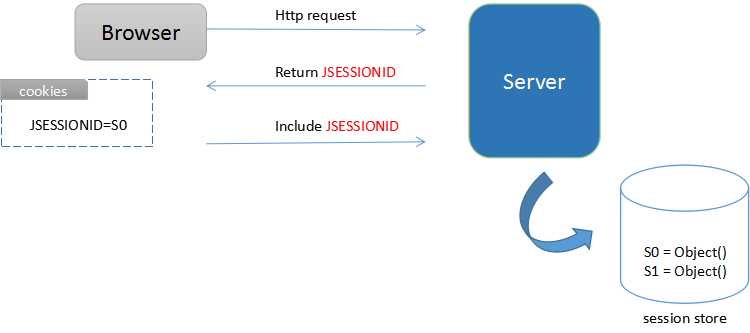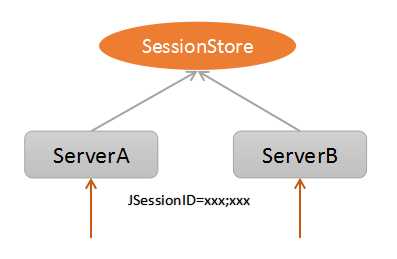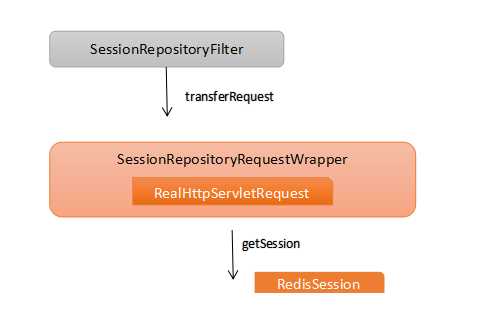标签:info 说明 response 连接 x86 ash boolean rri 形式
目录
在 补习系列(3)-springboot 几种scope 一文中,笔者介绍过 Session的部分,如下:

对于服务器而言,Session 通常是存储在本地的,比如Tomcat 默认将Session 存储在内存(ConcurrentHashMap)中。
但随着网站的用户越来越多,Session所需的空间会越来越大,同时单机部署的 Web应用会出现性能瓶颈。
这时候需要进行架构的优化或调整,比如扩展Web 应用节点,在应用服务器节点之前实现负载均衡。
那么,这对现有的会话session 管理带来了麻烦,当一个带有会话表示的Http请求到Web服务器后,需求在请求中的处理过程中找到session数据,
而 session数据是存储在本地的,假设我们有应用A和应用B,某用户第一次访问网站,session数据保存在应用A中;
第二次访问,如果请求到了应用B,会发现原来的session并不存在!
一般,我们可通过集中式的 session管理来解决这个问题,即分布式会话。

[图 - ] 分布式会话
在前面的文章中介绍过Redis 作为缓存读写的功能,而常见的分布式会话也可以通过Redis来实现。
在SpringBoot 项目中,可利用spring-session-data-redis 组件来快速实现分布式会话功能。
引入框架
<!-- redis -->
<dependency>
<groupId>org.springframework.boot</groupId>
<artifactId>spring-boot-starter-data-redis</artifactId>
<version>${spring-boot.version}</version>
</dependency>
<!-- redis session -->
<dependency>
<groupId>org.springframework.session</groupId>
<artifactId>spring-session-data-redis</artifactId>
<version>1.3.3.RELEASE</version>
</dependency>同样,需要在application.properties中配置 Redis连接参数:
spring.redis.database=0
spring.redis.host=127.0.0.1
spring.redis.password=
spring.redis.port=6379
spring.redis.ssl=false
#
## 连接池最大数
spring.redis.pool.max-active=10
## 空闲连接最大数
spring.redis.pool.max-idle=10
## 获取连接最大等待时间(s)
spring.redis.pool.max-wait=600接下来,我们需要在JavaConfig中启用分布式会话的支持:
@Configuration
@EnableRedisHttpSession(maxInactiveIntervalInSeconds = 24
* 3600, redisNamespace = "app", redisFlushMode = RedisFlushMode.ON_SAVE)
public class RedisSessionConfig {属性解释如下:
| 属性 | 说明 |
|---|---|
| maxInactiveIntervalInSeconds | 指定时间内不活跃则淘汰 |
| redisNamespace | 名称空间(key的部分) |
| redisFlushMode | 刷新模式 |
至此,我们已经完成了最简易的配置。
通过一个简单的例子来演示会话数据生成:
@Controller
@RequestMapping("/session")
@SessionAttributes("seed")
public class SessionController {
private static final Logger logger = LoggerFactory.getLogger(SessionController.class);
/**
* 通过注解获取
*
* @param counter
* @param response
* @return
*/
@GetMapping("/some")
@ResponseBody
public String someSession(@SessionAttribute(value = "seed", required = false) Integer seed, Model model) {
logger.info("seed:{}", seed);
if (seed == null) {
seed = (int) (Math.random() * 10000);
} else {
seed += 1;
}
model.addAttribute("seed", seed);
return seed + "";
}上面的代码中,我们声明了一个seed属性,每次访问时都会自增(从随机值开始),并将该值置入当前的会话中。
浏览器访问 http://localhost:8090/session/some?seed=1,得到结果:
2153
2154
2155
...此时推断会话已经写入 Redis,通过后台查看Redis,如下:
127.0.0.1:6379> keys *
1) "spring:session:app:sessions:expires:732134b2-2fa5-438d-936d-f23c9a384a46"
2) "spring:session:app:expirations:1543930260000"
3) "spring:session:app:sessions:732134b2-2fa5-438d-936d-f23c9a384a46"如我们的预期产生了会话数据。
示例代码可从 码云gitee 下载。
https://gitee.com/littleatp/springboot-samples/
接下来,继续尝试查看 Redis 所存储的会话数据
127.0.0.1:6379> hgetall "spring:session:app:sessions:8aff1144-a1bb-4474-b9fe-593
a347145a6"
1) "maxInactiveInterval"
2) "\xac\xed\x00\x05sr\x00\x11java.lang.Integer\x12\xe2\xa0\xa4\xf7\x81\x878\x02
\x00\x01I\x00\x05valuexr\x00\x10java.lang.Number\x86\xac\x95\x1d\x0b\x94\xe0\x8b
\x02\x00\x00xp\x00\x01Q\x80"
3) "sessionAttr:seed"
4) "\xac\xed\x00\x05sr\x00\x11java.lang.Integer\x12\xe2\xa0\xa4\xf7\x81\x878\x02
\x00\x01I\x00\x05valuexr\x00\x10java.lang.Number\x86\xac\x95\x1d\x0b\x94\xe0\x8b
\x02\x00\x00xp\x00\x00 \xef"
5) "lastAccessedTime"
6) "\xac\xed\x00\x05sr\x00\x0ejava.lang.Long;\x8b\xe4\x90\xcc\x8f#\xdf\x02\x00\x
01J\x00\x05valuexr\x00\x10java.lang.Number\x86\xac\x95\x1d\x0b\x94\xe0\x8b\x02\x
00\x00xp\x00\x00\x01gtT\x15T"
7) "creationTime"
8) "\xac\xed\x00\x05sr\x00\x0ejava.lang.Long;\x8b\xe4\x90\xcc\x8f#\xdf\x02\x00\x
01J\x00\x05valuexr\x00\x10java.lang.Number\x86\xac\x95\x1d\x0b\x94\xe0\x8b\x02\x
00\x00xp\x00\x00\x01gtT\x15T"发现这些数据根本不可读,这是因为,对于会话数据的值,框架默认使用了JDK的序列化!
为了让会话数据使用文本的形式存储,比如JSON,我们可以声明一个Bean:
@Bean("springSessionDefaultRedisSerializer")
public Jackson2JsonRedisSerializer<Object> jackson2JsonSerializer() {
Jackson2JsonRedisSerializer<Object> jackson2JsonRedisSerializer = new Jackson2JsonRedisSerializer<>(
Object.class);
ObjectMapper mapper = new ObjectMapper();
mapper.setSerializationInclusion(Include.NON_NULL);
mapper.enableDefaultTyping(ObjectMapper.DefaultTyping.NON_FINAL);
jackson2JsonRedisSerializer.setObjectMapper(mapper);
return jackson2JsonRedisSerializer;
}
需要 RedisSerializer 定义为springSessionDefaultRedisSerializer的命名,否则框架无法识别。
再次查看会话内容,发现变化如下:
127.0.0.1:6379> hgetall "spring:session:app:sessions:d145463d-7b03-4629-b0cb-97c
be520b7e2"
1) "lastAccessedTime"
2) "1543844570061"
3) "sessionAttr:seed"
4) "7970"
5) "maxInactiveInterval"
6) "86400"
7) "creationTime"
8) "1543844570061"RedisHttpSessionConfiguration 类定义了所有配置,如下所示:
@Bean
public RedisTemplate<Object, Object> sessionRedisTemplate(
RedisConnectionFactory connectionFactory) {
RedisTemplate<Object, Object> template = new RedisTemplate<Object, Object>();
template.setKeySerializer(new StringRedisSerializer());
template.setHashKeySerializer(new StringRedisSerializer());
if (this.defaultRedisSerializer != null) {
template.setDefaultSerializer(this.defaultRedisSerializer);
}
template.setConnectionFactory(connectionFactory);
return template;
}可以发现,除了默认的值序列化之外,Key/HashKey都使用了StringRedisSerializer(字符串序列化)
通常SpringBoot 内嵌了 Tomcat 或 Jetty 应用服务器,而这些HTTP容器都实现了自己的会话管理。
尽管容器也都提供了会话管理的扩展接口,但实现各种会话管理扩展会非常复杂,我们注意到
spring-session-data-redis依赖了spring-session组件;
而spring-session实现了非常丰富的 session管理功能接口。
RedisOperationsSessionRepository是基于Redis实现的Session读写类,由spring-data-redis提供;
在调用路径搜索中可以发现,SessionRepositoryRequestWrapper调用了会话读写类的操作,而这正是一个实现了HttpServletRequest接口的代理类!
源码片段:
private S getSession(String sessionId) {
S session = SessionRepositoryFilter.this.sessionRepository
.getSession(sessionId);
if (session == null) {
return null;
}
session.setLastAccessedTime(System.currentTimeMillis());
return session;
}
@Override
public HttpSessionWrapper getSession(boolean create) {
HttpSessionWrapper currentSession = getCurrentSession();
if (currentSession != null) {
return currentSession;
}
String requestedSessionId = getRequestedSessionId();
if (requestedSessionId != null
&& getAttribute(INVALID_SESSION_ID_ATTR) == null) {
S session = getSession(requestedSessionId);
至此,代理的问题得到了解答:

spring-session 通过过滤器实现 HttpServletRequest 代理;
在代理对象中调用会话管理器进一步进行Session的操作。
这是一个代理模式的巧妙应用!
我们注意到在查看Redis数据时发现了这样的 Key
1) "spring:session:app:sessions:expires:732134b2-2fa5-438d-936d-f23c9a384a46"
2) "spring:session:app:expirations:1543930260000"
这看上去与 Session 数据的老化应该有些关系,而实际上也是如此。
我们从RedisSessionExpirationPolicy可以找到答案:
当 Session写入或更新时,逻辑代码如下:
public void onExpirationUpdated(Long originalExpirationTimeInMilli,
ExpiringSession session) {
String keyToExpire = "expires:" + session.getId();
//指定目标过期时间的分钟刻度(下一分钟)
long toExpire = roundUpToNextMinute(expiresInMillis(session));
...
long sessionExpireInSeconds = session.getMaxInactiveIntervalInSeconds();
//spring:session:app:sessions:expires:xxx"
String sessionKey = getSessionKey(keyToExpire);
...
//spring:session:app:expirations:1543930260000
String expireKey = getExpirationKey(toExpire);
BoundSetOperations<Object, Object> expireOperations = this.redis
.boundSetOps(expireKey);
//将session标记放入集合
expireOperations.add(keyToExpire);
//设置过期时间5分钟后再淘汰
long fiveMinutesAfterExpires = sessionExpireInSeconds
+ TimeUnit.MINUTES.toSeconds(5);
expireOperations.expire(fiveMinutesAfterExpires, TimeUnit.SECONDS);
...
this.redis.boundValueOps(sessionKey).expire(sessionExpireInSeconds,
TimeUnit.SECONDS);
}
//设置会话内容数据(HASH)的过期时间
this.redis.boundHashOps(getSessionKey(session.getId()))
.expire(fiveMinutesAfterExpires, TimeUnit.SECONDS);而为了达到清除的效果,会话模块启用了定时删除逻辑:
public void cleanExpiredSessions() {
long now = System.currentTimeMillis();
//当前刻度
long prevMin = roundDownMinute(now);
String expirationKey = getExpirationKey(prevMin);
//获取到点过期的会话表
Set<Object> sessionsToExpire = this.redis.boundSetOps(expirationKey).members();
this.redis.delete(expirationKey);
//逐个清理
for (Object session : sessionsToExpire) {
String sessionKey = getSessionKey((String) session);
touch(sessionKey); //触发exist命令,提醒redis进行数据清理
}
}于是,会话清理的逻辑大致如下:
这里 存在一个疑问:
既然 使用了时间槽集合,那么集合中可以直接存放的是 会话ID,为什么会多出一个"expire:{sessionID}"的键值。
在定时器执行清理时并没有涉及会话数据(HASH)的处理,而仅仅是对Expire键做了操作,是否当前存在的BUG?
有了解的朋友欢迎留言讨论
分布式会话解决了分布式系统中会话共享的问题,集中式的会话管理相比会话同步(Tomcat的机制)更具优势,而这也早已成为了常见的做法。
SpringBoot 中推荐使用Redis 作为分布式会话的解决方案,利用spring-session组件可以快速的完成分布式会话功能。
这里除了提供一个样例,还对spring-session的序列化、代理等机制做了梳理,希望能对读者有所启发。
欢迎继续关注"美码师的补习系列-springboot篇" ,期待更多精彩内容^-^
标签:info 说明 response 连接 x86 ash boolean rri 形式
原文地址:https://www.cnblogs.com/littleatp/p/10128852.html